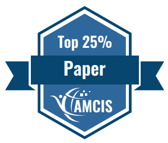Healthcare Informatics & Health Information Technology (SIG Health)
Loading...
Paper Type
Complete
Paper Number
1723
Description
Coronavirus disease 2019 (COVID-19) has been one of the most severe global pandemics in the 21st century. By the end of 2020, more than 83 million cases were confirmed, and more than 1.6 million deaths were reported globally. Understanding how COVID-19 spreads across diverse communities is key to public health surveillance and management for such a devastating and highly infectious disease. Current studies mainly analyze either non-human factors or human factors, focusing on a limited number of variables that can influence COVID-19 transmission. However, in a real-world context, these factors interact with each other and collectively shape the infection rate curve. Therefore, a comprehensive study based on both non-human and human factors on a large scale is required to fully understand disease transmission. Here, we propose a research framework named Comprehensive Understanding via Representative Variable Exploration for COVID-19 (CURVE4COVID). With the accessibility of various data online, including COVID-19-related Google Trends (e.g., human search behavior) and government-managed data (e.g., weather, air pollution, economic indicators), we conduct a large-scale and multi-variable analysis of the critical factors for COVID19 transmission, which can shed light on the complexity of infectious disease management. The results demonstrate that combining non-human and human factors provides better predictive power for infection rates than non-human factors or human factors alone. This study’s findings can provide new insights into disease transmission and help policymakers enhance preventative measures and healthcare management, thus having a far-reaching impact on society.
Recommended Citation
Serrano, Patrick and Huangfu, Luwen, "CURVE4COVID: Comprehensive Understanding via Representative Variable Exploration for COVID-19" (2021). AMCIS 2021 Proceedings. 27.
https://aisel.aisnet.org/amcis2021/healthcare_it/sig_health/27
CURVE4COVID: Comprehensive Understanding via Representative Variable Exploration for COVID-19
Coronavirus disease 2019 (COVID-19) has been one of the most severe global pandemics in the 21st century. By the end of 2020, more than 83 million cases were confirmed, and more than 1.6 million deaths were reported globally. Understanding how COVID-19 spreads across diverse communities is key to public health surveillance and management for such a devastating and highly infectious disease. Current studies mainly analyze either non-human factors or human factors, focusing on a limited number of variables that can influence COVID-19 transmission. However, in a real-world context, these factors interact with each other and collectively shape the infection rate curve. Therefore, a comprehensive study based on both non-human and human factors on a large scale is required to fully understand disease transmission. Here, we propose a research framework named Comprehensive Understanding via Representative Variable Exploration for COVID-19 (CURVE4COVID). With the accessibility of various data online, including COVID-19-related Google Trends (e.g., human search behavior) and government-managed data (e.g., weather, air pollution, economic indicators), we conduct a large-scale and multi-variable analysis of the critical factors for COVID19 transmission, which can shed light on the complexity of infectious disease management. The results demonstrate that combining non-human and human factors provides better predictive power for infection rates than non-human factors or human factors alone. This study’s findings can provide new insights into disease transmission and help policymakers enhance preventative measures and healthcare management, thus having a far-reaching impact on society.
When commenting on articles, please be friendly, welcoming, respectful and abide by the AIS eLibrary Discussion Thread Code of Conduct posted here.



